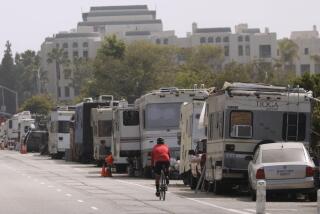Owners Ordered to Secure Quake-Damaged Buildings : Aftermath: Move is part of L.A.’s strategy to raze or rebuild structures that lured trespassers.
SYLMAR — In the latest step in their attack on “ghost towns,” city officials taped signs to cracked walls Wednesday, ordering apartment owners to secure their earthquake-damaged buildings before the city steps in.
The move is part of Los Angeles’ strategy to either demolish or rebuild apartment buildings in areas where damaged and vacant units have attracted looters, prostitutes, drug dealers and other trespassers. The notices give owners five days to fence, board up or remove debris from their buildings.
Owners welcomed the step because the city, using federal funds, will secure buildings in the ghost towns--13 neighborhoods identified as areas of concentrated destruction--if owners do not.
At a cluster of vacant apartment buildings near Hubbard Street in Sylmar, apartment and condominium owners said that in some cases vandals had caused more than twice as much damage as the Jan. 17 earthquake.
“The damage went from about $5,000 to $10,000 per unit, to something like $25,000 per unit,” said Victor Nuguid, who owns six quake-damaged and now vacant buildings on Hubbard Street.
Each of the six buildings Nuguid owns was made uninhabitable by the quake. Now, each has been broken into by thieves.
In one of his units, intruders ripped up a section of the living room floor and built a huge bonfire. The blaze threatened to engulf the building before firefighters put it out.
Throughout Nuguid’s buildings, thieves broke sliding glass doors or kicked holes in walls to get into apartments, where they stole everything from the copper piping on water heaters to sofa beds and refrigerators.
“I had everything boarded up, but they just kept breaking in,” Nuguid said.
But while touring the neighborhood Wednesday, officials from the city’s departments of housing and building and safety maintained that the program to secure the buildings was not too late.
“We realized this was a citywide problem, but it took us this long to map it out,” said Robert Moncrief, director of the city Housing Department’s Major Projects Division. “So taking this step now ends the chance that there will be a fire.
“The first step is to stop the vandalism so we can keep the buildings from being further devastated.”
For the cost of securing, policing and clearing rubble away from the 13 ghost towns that contain 6,000 housing units around the city, a task force identified about $240 million in local and federal money that had been set aside for other uses. A key role in obtaining those funds was played by Federal Emergency Management Agency Director James Witt, who agreed to contribute to the security measures.
On Tuesday, the Small Business Administration agreed to review 28,000 disaster loan applications that were denied or withdrawn and give top priority to loan requests from property owners in ghost towns.
Moncrief said that after the buildings are secure, the city will make loans to owners of quake-damaged complexes and press financial institutions to do likewise.
“We’ve contacted all the mortgage holders on the street, and we’re hopeful we can work out some arrangement so the situation doesn’t get any worse,” Moncrief said about the Sylmar neighborhood.
Moncrief said the process will be complicated, however, because the Sylmar ghost town involves 13 apartment or condominium complexes, 27 owners and 22 lenders.
But Pam Nelson, who owns a condo at the red-tagged El Dorado Avenue Townhomes, said she was happy about the government attention anyway.
During the past several months, she has watched her abandoned home become a haven for prostitutes, pimps, drug users and gang members with an affinity for marking indoor walls. A $1,500 chain-link fence did little to keep them out, she said.
“I’ve been working six months so we could get more security here,” Nelson said. “This is a big deal.”
Pausing and pointing out a section of dead grass that used to be green and a weather-beaten couch dumped in front of her building, she said: “I really used to like living here. I guess it’s hard to believe that now.”
More to Read
Sign up for Essential California
The most important California stories and recommendations in your inbox every morning.
You may occasionally receive promotional content from the Los Angeles Times.










